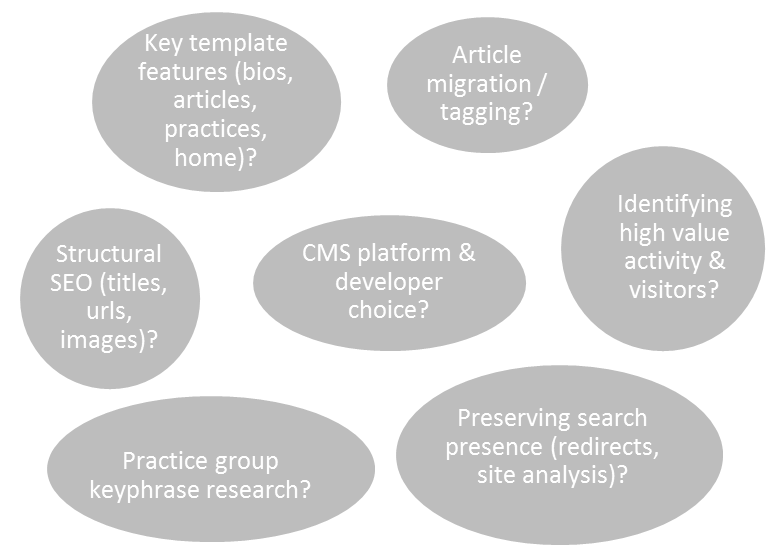In providing website analytics for large numbers of legal and accounting firms we get a birds-eye view of what happens after website revamps.
And revamps are common: about every 5 years as web technologies, brand refreshes, and new marketing directors come and go.
The results are often surprising. For example, the majority of firms see net falls in traffic after rebuilds (by the way it can be harder to see the traffic fall if your developer replaces your analytics with a new account).
So here are the top seven problems to be aware of before you do your website rebuild.
1. Not choosing the platform before finding your web developer
In the old days you built a website from scratch. These days your content management system (WordPress, Drupal, Kentico etc) should be the first thing you think about.
Decide which CMS you want to use (long term development cost, numbers of contractors with familiarity, plugin ecosystem etc) and then choose your development company.
Don’t choose a web developer first and get their default platform: it’s like bypassing the architect and letting your builder design your house.
Different developers will have different expertise in CMS platforms. And some will try to steer you in the direction of niche CMS’s, bespoke inhouse platforms or continuous-scroll single page applications because they achieve better client lock-in that way (you will sometimes hear arguments about big CMS systems being insecure, not customizable enough etc but be skeptical).
Read more here about which CMS platform we normally recommend: we don’t do web development for others so we can afford to be candid about development issues as we see them.
2. Not properly planning and resourcing the migration of your existing website and its articles
Most professional service firm websites have been around for a long time now (at least a decade).
To re-use the building metaphor, website rebuilds are not greenfield projects, they are like renovating a heritage-listed house with zealous local council inspectors (Google crawlers) dropping in to see what you’ve done.
Your current and future website presence rests on the content foundations you already have – don’t destroy them as these days the web is highly competitive. Budget and plan for migrating as many articles as you can. Most new visitors to your website will hit an article first and 20% of your top articles will likely be several years old (Google doesn’t care an article is old and you shouldn’t either).
Migrating significant numbers of articles often also involves taxonomy choices and indexing work. For example we will typically do topic categorisation, re-titling, url redirects and author linking for clients because they can’t easily resource that themselves (where we have significant editorial teams).
3. Not structuring your new website to distinguish valuable vs volume traffic
Not all visitors to a professional services firm’s website are equal. You should be structuring your site to be able to identify the high value activities that help generate real new business leads (and distinguish existing clients for that matter). It’s possible to track 100% (not a typo) of contact with fee earners via the website with the right structure.
There are a number of steps like not having your contact details in the footer of every page. You’ve just lost the ability to see what causes people to actually contact you (because you can’t track the clicks to the ‘Contact Us’ menu). And, having been through this exercise with many firms, numbers of prospects phoning won’t drop if you have the well accepted ‘Contact Us’ navigation convention.
4. Not effectively preserving your search presence
Every page on your existing site has a presence in Google and in our website benchmarking search accounts for 60-70% of traffic and correlates strongly with the high value activities we refer to above.
Don’t like the copy on your IP practice page? Rewrite it and thereby remove the keyphrase ‘Madrid application’ you already ranked well for in search and you have just shot yourself in the foot. You should start your content rewrite by looking at your analytics first to help you understand which pages really need rewrites.
You also need to correctly implement redirects which simply tell search engines that the page at lawfirm.com/old-publication URL is now at lawfirm.com/new-location-for-old-publication and that its search reputation for keyphrases A, B and C should be transferred accordingly.
Check how many pages you currently have indexed in Google and that’s a rough indication of how many individual redirects you’ll need. We see too many revamps doing a group-redirect (all individual old publication pages being group-redirected to the single new Publications Homepage on the revamped site for example). This doesn’t work – Google can’t find keyphrases A, B and C on the Publications Homepage and therefore drops the old page’s reputation and your hard-won search traffic slumps likewise.
In helping firms with revamps we find they also often miss unexpected redirects – for example printurl versions of articles they didn’t even realize appeared in search results.
Ironically one of the worst things (just in terms of search presence) that can happen is a merger with an overseas firm.
It’s ironic because the merger’s rationale was to get BigLawFirm a footprint in country X and the day after the merger finalizes they shut down the local firm’s website and redirect any request for that domain to their homepage in the UK or US (and doubly ironic because as an overseas website BigLawFirm.com doesn’t appear in country X local content searches).
5. Not doing keyphrase research for your most important practice groups
These days if you want to be competitive in search (not wanting to belabor the point but remember, 60-70% of your traffic) casual thinking about website copy is not enough.
You need to understand how it is that prospective clients really search for information for at least your top 4 or 5 practice groups as opposed to how you would like them to.
So, although unsettling for IP lawyers, the public may not search for “applying for a trade mark” but instead for “get a trademark“. Or in family law they may search for “alimony” not because they are in the U.S. but simply because they watch US TV serials.
So for each major practice group you should end up with the top hundred or so keyphrases prioritized both by search frequency and by internal importance (there may be some low frequency searches which are very profitable matters). It’s usually a good idea to carry out a post-keyphrase research interview with a fee earner in that practice group to identify lower frequency matters that are profitable as well as possible keyphrases missed.
6. Not applying your practice group keyphrase research correctly
Once you have your keyphrase research it needs to be applied to your new site effectively. That means thinking about the weighting that Google applies to specific page elements like titles, subdirectory paths, navigation etc.
It does not mean adopting the same url structure that all your competitors have for their websites. And it needs to be balanced against other considerations like tracking and readability.
7. HIPPO*-driven decisions about features on your most important page templates
Deciding what features to have on key page types (lawyer or accountant bios, articles, practice group pages), should not just be a matter of personal taste.
There’s data (talk to us or we update our best practice recommendations in GA+) on what features work best on different law firm and accounting firm page types (for example if you think Vcards are old technology and don’t belong on fee earner profile pages you might want to rethink that) and even what is best practice in a homepage.
Try (we know it’s not always possible) to avoid ‘who shouts loudest’ decisionmaking here – there are visual design decisions which may be a matter of personal taste and there are functionality decisions, and the two sorts of decisions should be made differently.
Also bear in mind that it’s often worth asking for evidence of functionality advice given by your website developer. For example recently a law firm told us their website developer advised them that print buttons shouldn’t be on their web pages because they were ‘old technology’ (actually one of the most frequently used functions we see in analytics projects in law firms).
Only a handful of website developers have experience working on multiple professional services firm website projects – they more often work on consumer or other B2B sites – and even fewer (none as far as we know) carry out detailed reviews of the effectiveness of their designs post-launch via the website’s analytics.
* Highest Individually Paid Partner's Opinion






